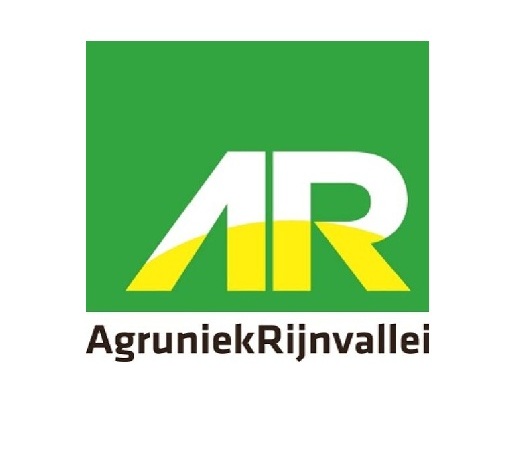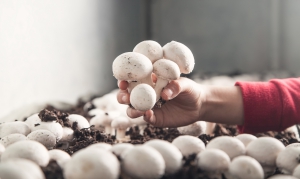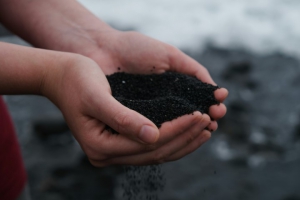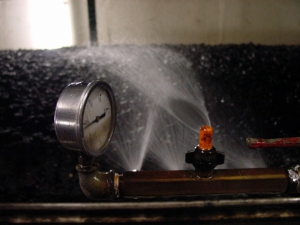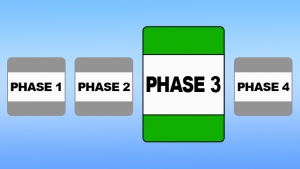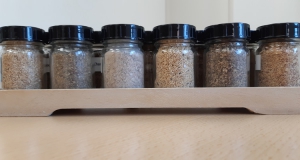Compost-casing-mushroom water relationships
The function of casing is to induce fruiting, support mushroom growth, and provide a source of water to the mushroom that compensates for its water lost through evaporation and transpiration. Sometimes, there has been an overemphasis on the influence of the moisture layer in the casing on mushroom yield and quality. A large variation in the compost substrate moisture may have more influence on mushroom yield and fresh mushroom quality. It is not to say that casing moisture does not influence yield or quality, but it may take a larger disparity in moisture to markedly influence the end product.
The mushroom relies on water potential gradients to move water through the mycelium. Water flows from regions of higher water potential to lower water potential, which helps maintain turgor pressure necessary for mycelial tip extension and growth. This same gradient also affects nutrient transport: nutrients, ions, and metabolites often move along with water via bulk flow or are actively transported across membranes, but their distribution is shaped by the underlying water potential differences within the mycelial network and between the fungus and the compost.
In a mycelial network, water potential gradients help the translocation of nutrients—moving them from the compost, the resource-rich region, to actively growing hyphal tips or fruiting bodies. Under dry conditions, the external water potential becomes too low, water movement into the hyphae slows, reducing nutrient uptake and impairing growth. Conversely, favorable water potential promotes efficient uptake and redistribution of resources throughout the mycelium.
Think of thicker rhizomorphs in the casing as the big pipes that move water and nutrients from the compost to the developing mushrooms. To keep mushrooms healthy and productive, this pipe system needs to stay in good working order all through the crop. Just like it’s easier to move water through a fire hose than a garden hose, well-developed rhizomorphs make water delivery more efficient. Keeping the casing wet or moist is what allows these larger “pipes” to form and continue feeding the mushrooms. If the casing dries out during production, most strains will give lower yields and poorer quality mushrooms. In the end, this whole water network relies on the compost as the main source of water for the crop.
Water is constantly moving during the cropping cycle. Mushrooms take up water into their cells, while water is also lost through evaporation and transpiration. Growers replace this loss mainly by watering the casing layer. However, we still know little about exactly how mushroom mycelium absorbs and transports water, or how water moves through rhizomorphs into the mushroom itself.
Some research suggests that water uptake depends on differences in water potential between the mycelium and the compost solution (Kalberer, 1987). As cropping progresses, mushrooms use water from both the compost and casing, while evaporation, transpiration, and respiration continually reduce the water content of the crop. This loss lowers the water potential inside mushroom cells. Because water moves from higher to lower potential, this gradient may allow mushrooms to absorb water with little energy cost. Another idea is that nutrient absorption helps drive water uptake (Holtz, 1971; 1979; Schroeder & Schisler, 1981; Kalberer, 1987). When nutrients are actively absorbed by the mycelium, the osmotic potential inside the cells decreases. Water then follows passively, moving in response to the concentration of nutrients. The developing mushrooms produce the sugar mannitol and therefore have a much higher concentration than the vegetative mycelium (Holtz, 1976). It was suggested that this different concentration of mannitol creates the osmotic and water potential gradient responsible for “pumping” nutrients and water from the compost mycelium through the casing rhizomorphs and into the developing mushrooms.
In summary, mushroom fruit body development depends on a balance of water movement between the compost, casing, and the developing fruit mushrooms. While casing moisture is important for yield and quality, compost moisture may play an even greater role. Water and nutrients move through the mycelium by water potential gradients, flowing from wetter regions in the compost toward drier hyphal tips and mushrooms. Rhizomorphs act like large pipes, efficiently transporting water and nutrients when casing moisture is maintained; if the casing dries, yields and quality decline. Water uptake is largely passive, driven by gradients in water and osmotic potential, which are influenced by nutrient absorption and the accumulation of compounds like mannitol in mushrooms. Together, these processes form a dynamic water transport system that sustains mushroom development throughout cropping.
REFERENCES
Holtz, R.B. 1971. Qualitative and quantitative analysis of free neutral carbohydrates in mushroom tissue by gas-liquid chromatography and mass spectrometry. J. Agr. Food Chem. 19 (6):1272-1273.
Holtz, R.B. and Smith, D.E. 1979. Lipid metabolism of mushroom mycelia. Mushroom Sci. 10 (Part 1):437-444.
Kalberer, P.P., 1987. Water potentials of casing and substrate and osmotic potentials of fruit bodies of Agaricus bisporus. Sci. Hort. 32:175-182.
Schroeder, G.M. and Schisler, L.C. 1981. Influence of compost and casing moisture on size, yield, and dry weight of mushrooms. Mushroom Sci. 11:495-509.
Compost Activity
Mushroom growers worldwide face the same problem: there are times during cultivation when the compost exhibits either more or less activity than desired. This can happen right after filling the compost, during ventilation, or if the compost temperature rises too quickly during the first flush, which can severely impact mushroom quality.
Most farms have this under control, but each grower must find the optimal formula for their own operation. This principle can be compared to a balance: if you change something on one side, you must adjust the other side to maintain equilibrium.
The entire process starts with filling the compost in the room. There are a few important factors to consider at this stage. The moisture content and structure of the compost are crucial for the expected activity right after filling. Dry compost with a lot of structure will show high activity immediately after filling. This compost should always be filled thicker to achieve the desired kilograms per square meter. This extra thickness is mainly filled with air, which acts as a buffer for heat.
Once the compost becomes active, this air warms up and is very difficult to cool down again. Compact it as firmly as possible. For wet compost with little structure, do the opposite: fill it loosely and avoid watering immediately after filling.
Mycelium Growth during incubation
If everything proceeds normally during the growth phase of the compost, the first signs of activity can be seen around day 9 after spawning. This activity increases as the compost continues to grow. By day 15, the compost should be fully colonized, and activity will start to decrease. If, for some reason, the compost needs to be covered or removed from the tunnel earlier, this activity will continue in the growing rooms. At that point, controlling this activity becomes very difficult because the casing soil acts like a blanket, retaining heat in the compost. In such cases, keep the air temperature in the room very low to maintain the compost temperature at 26°C. This will also cool the casing soil, preventing mycelium growth in it.
Supplementing
Supplementing the compost provides extra activity. The level of activity depends on the type and amount of supplement used. Typically, 15 kilograms of supplement per 1,000 kilograms of phase 3 compost yields optimal results. However, this depends greatly on the compost. If the compost has a high nitrogen content, 15 kilograms might be too much. Supplementing is an excellent way to increase both the quantity and quality of mushrooms, but the compost must be free of competitive mold infections. Infected compost can react negatively to supplements because these are also food sources for competitive molds, which can harm the mycelium or mushrooms, negating any benefits of supplementation.
Filling Weight
Filling weight is a crucial factor for compost activity and significantly affects the total mushroom yield. Generally, a 10% increase in compost results in a 10% increase in mushrooms. This is true, but the climate unit must be able to manage the additional compost. Again, it's about balancing the ability to handle increased activity with the potential yield benefits.
As you can see, the desired but sometimes troublesome activity of compost depends on many factors. Literature provides ideal filling weights, but in practice, it varies from farm to farm. Growers must determine the ideal ratios for their specific operations.
Total Mushroom Service
Jeroen van Lier
Dirty bunker pipes
Not hard to imagine that reduced air flow going into the compost is not good for the quality of the compost. To maintain high-quality compost, it's crucial to keep the pipes under the bunker floor clean and free from blockages. Blocked pipes can lead to water accumulation on the bunker floor as the water will not drain, and create anaerobic conditions, harming the composting process. Set up a routine to clean all the pipes thoroughly every three months. Use a hose to flush out any dirt and debris, ensuring proper airflow throughout the composting process.
Ensuring thorough cleaning of the blocked pipes is crucial, as simply flushing them with water from front to back may not be sufficient. Despite water passing through, dirt can still accumulate inside the pipes. Achieving a satisfactory result involves reaching the end of the pipes with a hose and utilizing back pressure to dislodge any remaining debris. Attached below is a picture showing completely blocked pipes and the dirt extracted from some of them. This visual evidence underscores the necessity of meticulous cleaning to maintain optimal functioning of the composting process.

When pipes get blocked in composting systems, some issues can pop up. You might see wet spots and areas without enough air (anaerobic zones) in the compost. This happens because the airflow needed for composting gets messed
up. When pipes are blocked, air can't move properly, making some parts of the compost lack oxygen. It will also be visible in the pressure on the bunker floor being reduced. All this isn't good for composting and can cause bad smells and slow decomposition.
It's important to be safe when dealing with blocked pipes in composting systems. Wear a good face mask to protect yourself from harmful gases that can build up in blocked pipes over time. Also, make sure to keep the area well-ventilated and follow safety rules to avoid accidents.
Erik de Groot
This email address is being protected from spambots. You need JavaScript enabled to view it.
https://www.mushroomsconsultant.com
Water, the ongoing discussion
If one wants to start a discussion with a grower (or with a consultant), start talking about watering.
How much, when and what watering method.
To make any sense though, you first have to define the period. There is watering on casing soil and watering over mushrooms and between flushes.
This blog is about watering on the casing soil during the incubation period. The water given in that period is to bring the casing soil up to the maximum moisture level and to keep the compost at the right moisture.
A good phase 3 compost at the moment of casing will be around 60% in moisture. For white strains that can be up to 3% higher, brown strains prefer 1 or 2% drier. It is not possible to bring the compost to a much higher moisture level by watering it after filling. It is possible to give water into the compost but that will be free water which has to disappear during the fructification period.
2 up to 4 litres of water can be given into the compost at filling or later but that should be the maximum. Even if it is necessary to cool the compost. This can better be done by giving water into the casing and let it evaporate with fresh air and circulation.
Casing soil itself can handle up to 7 litres per m² plus the water that was originally in the casing. To be sure, we talk about a casing containing white and black peat.
More than 7 litres will evaporate, go into the compost or down the drain.
Considering that the evaporation can be around 2 litres per m² per day, the loss with evaporation is about 10 litres. If you count the loss of dripping, the water staying in the compost and the evaporation you come to a figure of about 25 litres of water. In practical situations this means a total amount of water between 20 and 30 litres average. Depending on the farm and the time of the year. Growing drier often means a loss of production and growing a lot wetter means problems in growing, mainly in the outgrow of mushrooms.
Another thing to watch for is the watering method. Make sure that the pressure of the water onto the casing is not too high. Too many times I see a casing with a damaged surface which will give problems in the evaporation.
Every system has a different pressure and if you are not sure, ask the manufacturer. Regularly cleaning of the nozzles is something will help maintaining the right pressure and the right adjustment of the watering trees, looking at distance and height according to the casing level.
Keep watering but do not take it over the top!!
More than half of the mushroom in Ukraine is grown on Phase 3 of compost – that is the result of a reduction in volumes.
According to information received by UMDIS agency from compost producers of Ukraine, demand for Phase 3 compost has decreased slightly compared to the same period last year.
At the same time, production of Phase 2 compost has more than halved due to reduced demand.
As a result of these changes, already in the summer of 2022, the volume of champignon mushrooms produced on Phase 3 compost will exceed the volume of champignon mushrooms grown on Phase 2 compost.
We will remind, as a result of Russian aggression, at the end of February-March, the majority of compost factories in Ukraine stopped soaking new batches of compost, and resumed this process only at the end of March, gradually increasing volumes.
In May 2022, the volume of compost orders in Ukraine reached approximately 60% of the pre-war level typical for this period.
However, the period of low prices for champignons in June and the whole summer negatively affected the optimism of mushroom growers, so today the production of compost in the country is about 50% of the level of the same period last year.
At the same time, the Grikar-APS compost plant in the Kharkiv region and the Agrotandem-Plus compost plant (Mriya SE) are not working.
Thus, 100% of compost for sale in Ukraine is now supplied to the market by 4 compost production companies: Agaris Miko Ukraine (Ternopil region), Agaris Miko Center (Cherkasy region), VG Farming (Veres, Cherkasy region), World of Straw (Mykolaiv region).
Phase 3 compost is offered by both Agaris and World of Straw plants.
Today we welcome Mertens Mushrooms on board!
We are happy to announce that Mertens Mushrooms from Holland has joined our mushroom community!
As a dedicated supplier, Mertens believes in good cooperation towards a healthy growth for every business. The company is well versed in professional agriculture, garden retail and landscaping, and passionately shares its expertise. From its roots in Limburg (The Netherlands), Mertens has developed into a down-to-earth, involved, and most of all reliable and knowledgeable partner.
Mertens has almost 70 years of experience, relies on a team of about 130 permanent employees, has its own vehicle fleet and over 7,000 products in stock. From this basis, Mertens has managed to acquire a leading position in the mushroom sector. When it comes to mushrooms, Mertens is even the world’s biggest player. Our team is active in 41 countries, spread over six continents.
Focus on prevention
Mertens offers a complete package of products for growers and tunnel companies: biocontrol, films, cultivation, compost and sliding mats, fogging equipment, scales and hygiene products. Mertens’ range clearly reflects the trends and developments within the sector, in which prevention is now paramount. Today crop protection products, mainly biological, are only used when absolutely necessary. An example of prevention within mushroom cultivation is the use of nematodes; this worm species plays an important role in the control of mosquitoes in cultivation. Mertens has guided growers intensively in the application of these nematodes. To be able to inform its customers in the best possible way, Mertens ensures that its own expertise is always kept up-to-date.
International growth
From its roots in Limburg (The Netherlands), Mertens’ mushroom branch has increasingly focused abroad. Mertens is now also active in the growing mushroom market China, often indirectly through other supplies or consultants. This is a logical development, knowing that the number of Dutch mushroom growers has decreased drastically in recent years. The extensive online communication possibilities facilitate remote contact. In addition, the Mertens website is a source of information and provides a sophisticated ordering system for both domestic and foreign customers. Among other things, mushroom growers can find order lists, safety sheets and product information here. Online sales have grown strongly in the last few years, but Mertens also attaches great value to personal contact.
Mertens is ready to help you!
Moving with the times, synergy with other sectors, cooperation, flexibility, adaptation to market needs… These are the characteristics that have brought Mertens to where it is today, and all this is combined with expert advice.
Meet our Mushroom Team! They will be happy to help you.
Supplement, the unknown ingredient?
If a consultant is visiting a farm there are always many things to discuss in detail.
Shall we give more or less water and are we able to water over the mushrooms?
Do we need a slower or faster fructification?
Is the amount of pins sufficient or do we need more and how do we then get a decent stagger?
Even discussions about compost although many growers do not really know the details. But they know about structure, moisture and smell. Because this is what they discuss at filling.
The same about casing soil. Is it heavy this time or just fine? Wet or dry?
But talking about supplement one finds out that most of the growers have absolutely no idea how it works, what it really is and the choices they can make. Generally the price is the main buying point.
And this is strange to me. Because compost and casing are always changing during the year. This is mainly due to the seasonal effect on the raw materials. Straw is maturing in the storage, chicken manure will change in nitrogen level and peat is changing moisture depending on the season of the year. Manufacturing companies will react to that but smaller changes are inevitable.
To keep production at the same level or to enhance it, the supplement however can be changed to your liking. Most of the growers only know that there is a slow or normal release product. But it is possible to customise the supplement to the situation of that moment. Not just slow or fast but even pinpointed to a certain phase of the growing. To give an example: one of the farms I work on now wanted more activity in second flushes and a longer shelflife. In cooperation with the compost supplier and the supplement supplier they have now “composed” a supplement that can do that. Be aware though that it also needs adapting of the growing. You are putting more proteins into the compost so the activity changes too. This means that also the watering and the picking have to change.
But this way many combinations are possible.
There are different raw materials to mix and several processes to make the release time fitting your schedule.
A few remarks though have to be made.
It only works well in cooperation with the compost supplier. The ingredients of the supplement have to be an addition to the nutrients in the compost. So it has to fit the analyses of the compost.
The best way to use it if it can be mixed in at the compost yard. And this is only profitable with bigger quantities of compost. Mixing it in at filling is not as efficient as on the compost yard.
Do not just look at protein levels. Because some proteins are not available to the mushrooms and will still be in the compost at the moment of emptying the room.
So look at effective protein. This often is a matter of price. Good proteins come with a price.
And remember: good supplement makes good compost better. But good supplement makes bad compost worse.
'As a mushroom sector to solve our own problems'
From the production of healthy food to attention to animal and plant health, from managing a beautiful and diverse landscape to contributing to a healthy economy: Limburg's farmers and horticulturists literally keep the province healthy. Today a conversation with entrepreneur Gerard Sikes from Ysselsteyn, who is well on his way to climate-neutral mushroom production.
Sikes (49) grew up on an arable farm, his wife Karin (49) on a mushroom farm. In 1988 they started cultivating mushrooms together.
'A nursery was for sale, but we could also have bought a sandwich shop or opened a bicycle shop,' says Sikes. 'What matters to us is doing business together.'
Every morning, around eight o'clock, the couple sits together at the table to discuss all current matters and the day ahead. 'A healthy relationship is the basis for our company. My wife gives feedback, is my complaint and teacher.'
Source: Nieuw Oogst (article is in Dutch)
Heavy casing soil, causing problems
The last month several growers had problems with a too heavy casing soil. It is normal for this time of the year for casing soil to be heavier because of rainfall on the peat fields. It takes a few weeks for the casing companies to sort this out and in the mean time the grower has to deal with this. A normal situation for this period. Complaining is not the way to deal with this but inter acting is possible.
The first thing to do is to recognize that the casing ís heavy. This can only be observed if good attention is given to the filling of the room. Always talk to the truck driver about compost and casing and you already know a lot. They know exactly what material they carry. If they say it is a heavy load and if water is coming out the first thing to do is to adjust the filling machine. Heavy casing soil packs more so it has to be opened up. The caccing spinner on the combine filling machine plays a big role in this. It has to pick up the compost and mix it well into the casing. Cac a bit more than normal if casing soil is heavy. The next step is to make the mixing spinner turn a bit slower. Too intensive mixing will destroy the structure and cause big problems in outgrow of the pins later on. The pressing roll should be adjusted that way that it does not close the holes in the casing. If you look at the roller from the side of the shelf, a little bit of light should be visible between roller and casing.
Then be careful with water on the first day. Make sure the caccing material starts growing. This can be seen by the attachment of the compost to the casing. Do not wait however till you really see the mycelium. Because then the time for watering can be too short. And mycelium will overgrow the casing. The normal amount of water can be given minus a few litres. (the water on day one). It is a good thing if watering gifts can be split into small doses. 1 litre at a time with intervals of at least 1 hour. Only on the first watering day (probably day 2 after filling) bigger gifts are possible.
The next thing that might happen is that the mycelium has difficulties growing to the surface. Remember, a heavy casing soil needs help to release water and CO2 so always make sure that fresh air is given to the room. A minimum of 5% fresh air most of the times helps a lot. If the mycelium has reached the surface generally the fructification is normal. The only difference is from day 7 to day 10 of the fructification. From that day 7, the pins might stagger in outgrow. At that moment again fresh air is needed to keep the evaporation going. A minimum of 5% might not be enough anymore. If you see pins but they do not grow out you have a few possibilities.
A drop of water as a shock. This means 0,5 litre of water and mild drying with heating and fresh air. Fan can be set up to 5% higher in speed.
Or you can drop the CO2 to about 1000 ppm for a day. But make sure that RH stays over 88% in this case.Overall the growing later on will be on a bit lower CO2 than normal to keep evaporation going. Watering as normal. The biggest mistake made is to keep rooms like this too dry. Be aware that the room might develop less pins than normal. Let them grow out and pay special attention to the picking. This way these rooms do not have to be any worse. On the contrary, often they are better (in a financial way) than normal.
Water, the ongoing discussion
If one wants to start a discussion with a grower (or with a consultant), start talking about watering.
How much, when and what watering method.
To make any sense though, you first have to define the period. There is watering on casing soil and watering over mushrooms and between flushes.
This blog is about watering on the casing soil during the incubation period. The water given in that period is to bring the casing soil up to the maximum moisture level and to keep the compost at the right moisture.
A good phase 3 compost at the moment of casing will be around 60% in moisture. For white strains that can be up to 3% higher, brown strains prefer 1 or 2% drier. It is not possible to bring the compost to a much higher moisture level by watering it after filling. It is possible to give water into the compost but that will be free water which has to disappear during the fructification period.
2 up to 4 litres of water can be given into the compost at filling or later but that should be the maximum. Even if it is necessary to cool the compost. This can better be done by giving water into the casing and let it evaporate with fresh air and circulation.
Casing soil itself can handle up to 7 litres per m² plus the water that was originally in the casing. To be sure, we talk about a casing containing white and black peat.
More than 7 litres will evaporate, go into the compost or down the drain.
Considering that the evaporation can be around 2 litres per m² per day, the loss with evaporation is about 10 litres. If you count the loss of dripping, the water staying in the compost and the evaporation you come to a figure of about 25 litres of water. In practical situations this means a total amount of water between 20 and 30 litres average. Depending on the farm and the time of the year. Growing drier often means a loss of production and growing a lot wetter means problems in growing, mainly in the outgrow of mushrooms.
Another thing to watch for is the watering method. Make sure that the pressure of the water onto the casing is not too high. Too many times I see a casing with a damaged surface which will give problems in the evaporation.
Every system has a different pressure and if you are not sure, ask the manufacturer. Regularly cleaning of the nozzles is something will help maintaining the right pressure and the right adjustment of the watering trees, looking at distance and height according to the casing level.
Keep watering but do not take it over the top!!




